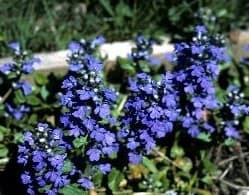How to Grow Ajuga Flowers

About Ajuga Flowers
Ajuga is a low-maintenance, vigorous-growing herbaceous plant. Ajuga flowers are evergreen to semi-evergreen. Some varieties are annual, others are perennial. This low-growing, flowering plant is a member of the mint family. Growing six to 18 inches, it has a spreading habit that makes for great ground cover on hills, embankments, and shady areas. Each plant can spread 6 – 18 inches. However, there is a downside to growing Ajuga. It is very aggressive and invasive plant that sends runners far and wide. The runners are called “stolons”. It can easily spread into your lawn and become nothing more than a lawn weed.
Ajuga is Native to Africa, Asia, Australia, and Europe. They are tough and durable plants. They can take some light foot traffic without serious damage. These plants are drought tolerant. They are also resistant to rabbits and deer.
Ajuga are aggressive plants. They can easily spread into lawns and areas of your flower garden where they are unwanted. As a result, some people consider them to be weeds. Use lawn edging as needed, to help contain them.
The plants are excellent ground cover. Landscapers use this tough plant to help protect an area from soil erosion. They are especially useful on hills and hard-to-reach areas. Try growing it in lightly shaded areas, like under trees, where other plants have a hard time growing.
With 40 varieties and glossy leaves, you can find a wide range of foliage colors.
Ajuga Plant Specifics
Flower Colors: Bright blue, pink, and white blossoms.
Flowers Bloom: Spring to Summer
Plant Height: 6 – 18 inches, 6 – 12 inches wide.
Ideal Soil pH: 4.5 – 6.5
Light Requirements: Full sun to partial shade
Hardiness Zones: 4 – 9
Native To: Australia, Europe, Northern Africa, Southwest Asia
Other Names: Bugleweed, ground pine, carpet bugle, bugle
Plant Type: Annuals and Perennials
Botanical Name: Lamiaceae
Are Ajuga Plants Edible?
Yes! As a member of the mint family, Ajuga plants are edible. Try them in soups, salads, and stir-fry recipes. You can also use the leaves in teas.
Note: While it is edible, it has a somewhat bitter taste.
Ajuga Medicinal Uses
The leaves of the Ajuga plant are primarily used in herbal and medicinal teas.
- Among the medicinal uses are:
- Treatment for rheumatic fever.
- Treat dysentery and malaria.
- Relieves hypertension.
- Helps control diabetes. Treatment for gastrointestinal ailments
- Also, it has anti-inflammatory, astringent, antifungal benefits.
Ajuga Flower Propagation
Ajuga plants propagate through wide-spreading roots, called “stalons”. Nodes develop along the root, producing more plants.
You can also propagate Ajuga by plant division. Dig up and divide clumps. Then, re-plant them in another location or in containers and pots.
Growing Ajuga Flowers as Houseplants or on the Deck
Why not!? While you don’t see much written about growing Ajuga indoors as a houseplant, you certainly can. This low maintenance plant, grows well in light shade, making it a great candidate to grow indoors as a houseplant. Like other plants, grown indoors, it will grow more slowly. It’s evergreen leaves offers greenery all year long. It may be harder to get Ajuga to bloom indoors. Plant it in a wide, shallow container.
Also, Ajuga grows well in containers on your patio or deck. Like other deck plants, they vigilant attention to soil moisture and nutrient levels in the container. Keep the soil moist not wet. Add liquid fertilizer every month.
Garden Tip: We recommend using wide, but shallow flowerpots. They plants spread to fill the flowerpot. However, the roots do not grow deep
How to Grow Ajuga Flower Plants
Ajuga are low-maintenance plants. They grow well in sun to light shade.
Ajuga flowers grow well in average soils and do not need a lot of fertilizer. In most soils, you do not need to add additional fertilizer or nutrients.
The plants are drought-tolerant. However, they grow best in moist, well-drained soil. Growing Ajuga on hills and embankments helps with drainage.
Plant roots with nodes in the spring after all danger of frost. Separate plants every 12-18 inches, depending on how quickly you want them to fill in an area. Dig just deep enough to bury the roots.
Ajuga plants form dense colonies. For best health and blooms, dig up and separate clumps of roots every 3-4 years.
Pruning Ajuga Plants
While not an absolute necessity, like with other plants, pruning is beneficial to the plants. It creates a more attractive appearance and helps to maintain plant health. Prune away dead and sickly leaves as necessary. To contain the spread of the plant, trim back runners a couple of times a year. Don’t be afraid to cut the plants way back, especially if you are trying to contain them.
Insects and Plant Disease
Ajuga plants have few insect problems. Spray with insecticides, only if needed.
The plant is susceptible to crown rot in wet soils and humid weather. Good air circulation helps to avoid this problem.
Also see: Plant Problems – causes and cures
Please support our site. Shop for:
- rmmatthews100@hotmail.com
- 585-721-6528
- Rochester, NY
©1999-2024 GardenersNet.Com, All Rights Reserved

